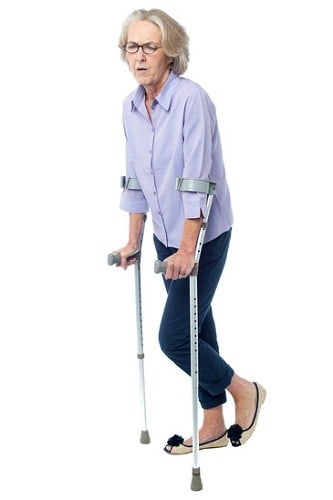Last Updated on February 6, 2021

Falls affecting seniors are among the main causes of severe injuries. It can lead to brain injuries, head traumas and other severe injuries requiring admissions to the hospital or nursing homes. While there are falls that do not lead to injuries, studies still show that a huge portion of non-injured fallers is unable to get up without an aid.
Major Causes of the Elderly Falling
If you are a senior, or you have senior parents or grandparents, learning about the primary falling elderly causes can greatly help in preventing them. Below are a number of major causes:
Inadequate Exercise
Failing to exercise on a regular basis is one of the main causes of seniors falling down. The reason behind this is that inadequate physical activities often lead to reduced bone mass and flexibility. It also results to the loss of your balance and reduced muscle tone. These problems often lead to difficulties in making proper movements, thereby resulting to the fall.
Vision Problems
Visual impairment is also a primary reason why the elderly falls. Those who reach an old age are often at risk of dealing with poor eyesight. Age related vision problems and not wearing the prescribed glasses also lead to having problems clearly seeing objects.
It should also be noted that older people who have glaucoma or cataracts have high risks of experiencing falls because of their limited vision. Most seniors fall at night because their vision problems result to being unable to get the right cues on how they should position their body. There are even those who have a hard time standing up straight without a chair or wall that can guide them to stay upright.
Certain Medications
There are medications prescribed to the elderly that cause adverse side effects like light-headedness and dizziness. This often results to falling because this makes it hard for them to stand straight or see things clearly. Taking over four medications or psychoactive medications also increases an adult’s chances of falling.
A wise tip in dealing with this problem is to let a pharmacist or doctor see your medications. Make sure to include those without prescriptions like treatments for cold. This is significant in determining which one causes adverse side effects.
Blood Pressure
Blood pressure in the elderly, which excessively drops when they get up after staying in a sitting or lying position for a long period, is one of the primary causes of falling in the elderly. Known as postural hypotension, this problem is triggered by the use of certain medications and excessive dehydration. Infections, diabetes and neurological diseases like Parkinson’s are also connected to the problem.
Inner-Ear Imbalance
Inner-ear imbalance affects over a third of the US population over 40, and by age 60, over half of the population is affected. According to a 2009 study at the John Hopkins Hospital, people with the condition tend to have as much as 12 times higher risks of falling than those who do not.
Vestibular dysfunction is the medical term for inner-ear imbalance. Symptoms include dizziness, sensation of movement when one is stationary, or else feelings of huge movements when only limited motion is present. All these can lead to a sense of imbalance in motion, which could explain why seniors with the condition have a higher chance of falling.
Weak Muscles
Weak muscles, especially those that form part of your legs, is also a reason for falling injuries. Seniors who have weak muscles have higher risks of falling than people who work hard in maintaining the strength, endurance and flexibility of their muscles.
Other significant falling elderly causes include normal changes related to aging such as poor eyesight and hearing, physical conditions and illnesses affecting balance and strength, absence of safety equipment and poor lighting.
Fortunately, there are ways of preventing the risk of elderly falling. Minimizing falls is possible through physical activities that enhance their strength, flexibility and mobility, limited intake of medications that induce sleep, and environmental modifications like grab bars installation, adding sufficient lighting, and tripping obstacles removal. In the next installment of this series, we will go into more details on fall prevention tips for the elderly.
Sometimes, falls still happen despite taking all the necessary precautions. For the elderly who live on their own, a fall alert button will enable them to call for help quickly. If a fall has happened and the elderly person is unable to get up on his or her own, the next most important thing to pay attention to is to get assistance fast, so as to stop the situation from deteriorating.
Statistical References:
Falls Among Older Adults – Center for Disease Control and Prevention
Incidence of and Risk Factors for Falls Following Hip Fracture in Community-dwelling Older Adults, 2004, Anne Shumway-Cook et al, Journal Of Physical Therapy
- Personal Safety Devices for the Elderly - March 5, 2023
- Two Different Bay Alarm Medical SOS Mobile Systems To Meet Your Needs - November 3, 2022
- Bay Alarm Medical Pricing 2022 Update - September 27, 2022
In a hurry? Leave us your email, we’ll follow-up with the best tips.

